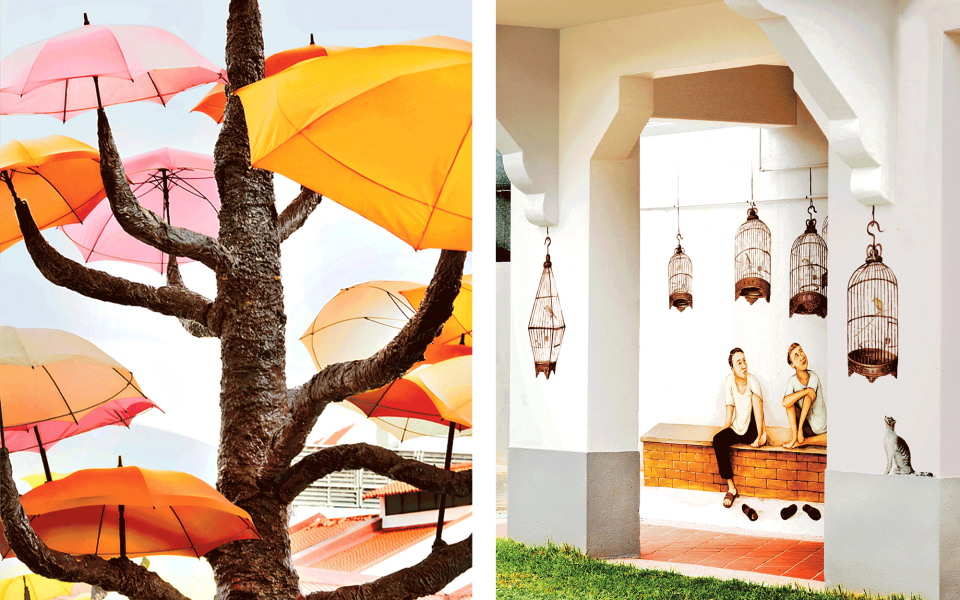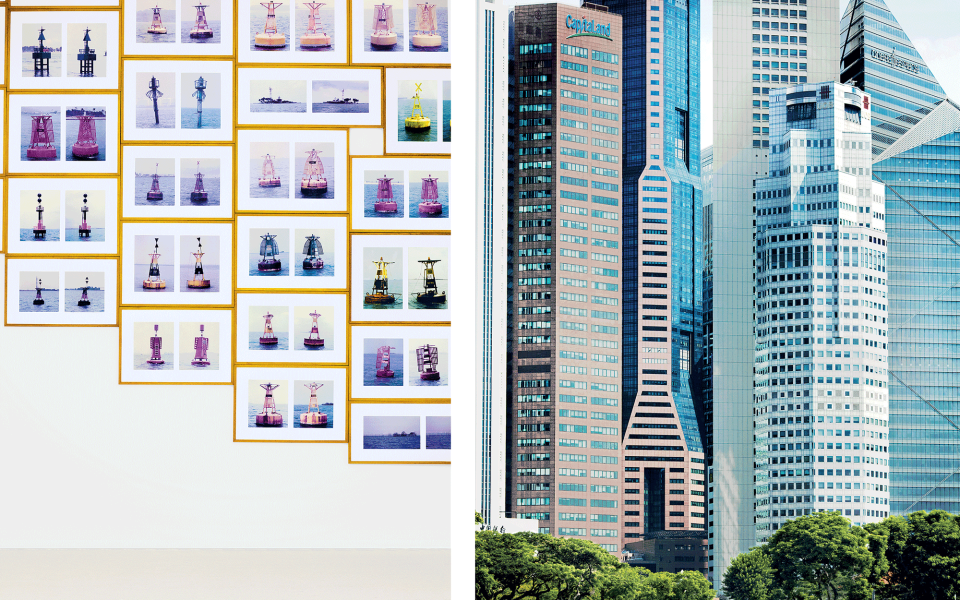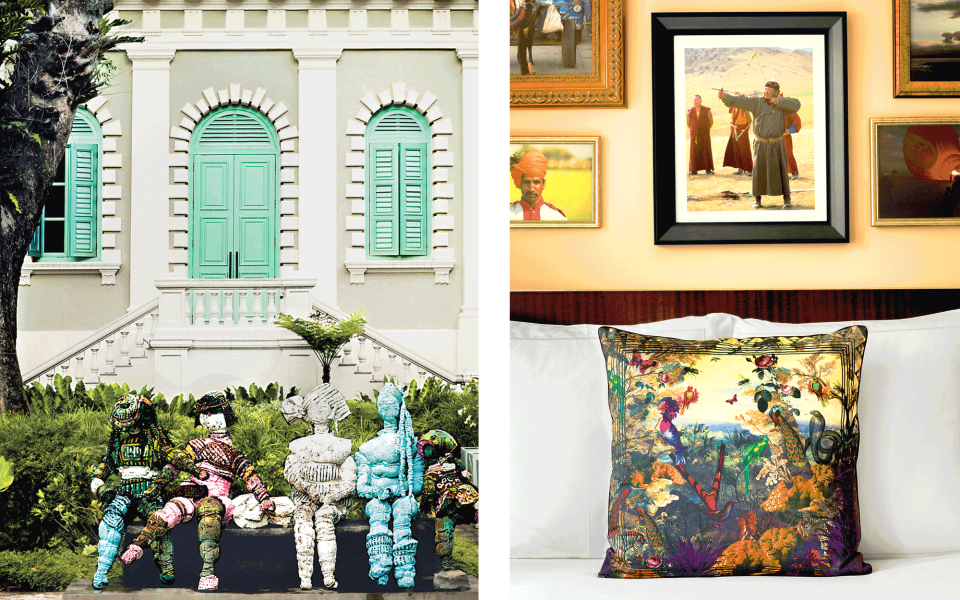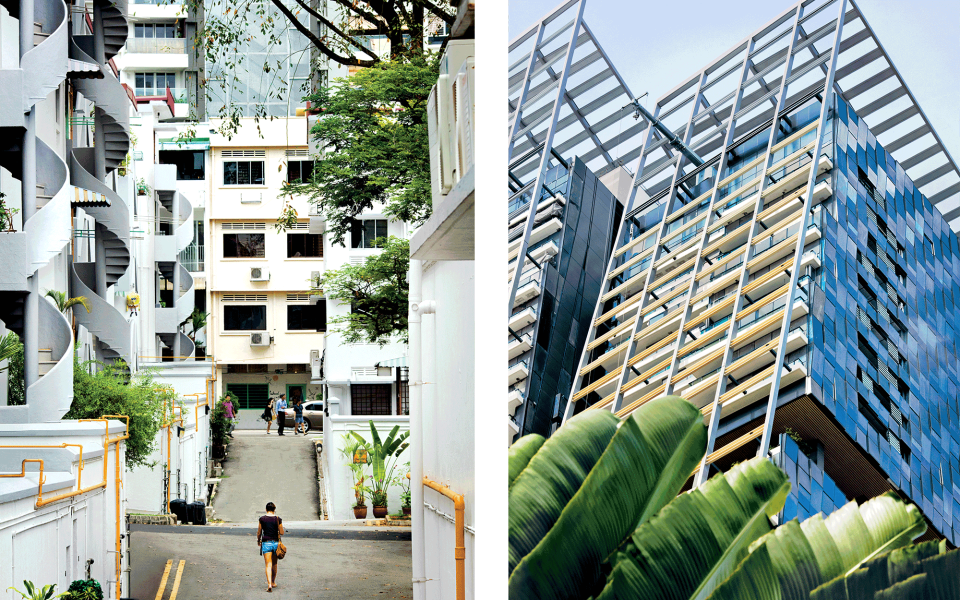Singapore is Spending Millions to Become a Capital of Creativity
There is no better emblem of Singapores artistic ambitions than its National Gallery, which opened last November. Standing before its stone bulk, I felt like an ant that had crept across the lawns of the Padang, the parade grounds where Singaporeans have gathered to mark momentous events in their historythe end of Japanese occupation in 1945, independence in 1965, and, just last year, the nations 50th birthday.
The building is, in fact, two. The government took a pair of colonial-era, Neoclassical monuments (the old copper-domed supreme court and the former city hall) and, with the help of Paris-based architects Studio Milou, bridged them. Held aloft by a giant metal trunk, the sparkling glass canopy resembles the majestic rain trees that grow throughout the city.
Theres also no better symbol of Singapores halting artistic development than this museum. On both of my visits, it was nearly empty, a cavernous temple with barely any worshippers.
That is understandablethe arts are a relative novelty for Singapore. Commerce has defined this city since it was founded, in 1819, as a British East India Company trading post. Its what lured two of my great-grandparents from Chinamy maternal grandfather was born hereshortly after 1900. When the city-state gained independence in 1965, it was poor. Back then, a tenth of its people were unemployed, and two-thirds lived in slums. Per-capita GDP hovered just below $4,000 (inflation-adjusted), about a sixth of that of the United States. Lee Kuan Yew, Singapores founding father, declared in 1969 that poetry is a luxury we cannot afford.

Singaporeanartist Jimmy Ongs work on display at FOST Gallery
Matthieu Salvaing
Lee, British-educated and urbane, was determined to enrich Singapore. His hand was far from invisible. His government revamped laws to attract foreign investment; mapped out an efficient, modern city infrastructure; and built homes for millions. Tiger Dadstyle, he emphasized education in practical fields: math, technology, engineering, science. Today, per-capita GDP has soared above $55,000, higher than that of the United States. Singaporewith its 5 million people and few natural resourceshas become one of the richest countries in the world.
The city-state can now afford all manner of luxuries, including poetry. Starchitect-designed skyscrapers punctuate the horizon, and a precinct of colonial buildings has been transformed into an elegant arts district. The calendar is filled with festivals, including the fifth Singapore Biennale, which runs from October through the end of February. Last year the government marked Singapores 50th anniversary with symposia in New York, London, and Beijing, dispatching artists to help cultivate its image as a cultural hub.
All this makes it a particularly fascinating time to experience ngapores cultural offerings. Government spending on the arts is approaching $700 million per year, a 3,000 percent increase from 25 years ago. With that money, the government has sought to construct a hothouse of what one might call Confucian creativity: orderly, pragmatic, respectful of elders and rules. While this is no longer the Singapore of chewing-gum bans and canings, bloggers are still arrested for violating laws meant to maintain harmony among Singapores ethnicities (74% Chinese, 13% Malay, and 9% Indian) and religions (34% Buddhist, nearly 20% Christian, 16% nonreligious, and 14% Muslim).

Left:An umbrella tree, oneof Little Indias public-art installations. Right: Amural on one of the oldest housing estates in Singapore's courtyard walls.
Matthieu Salvaing
The effect of such official efforts is that Singapores creativity has been less like the vigorous riot of vines and trees that grow in these tropical climes than a collection of delicate orchids (aptly, the national flower), trained and coddled. Yet this may be changing with the emergence of a generation of artists engaged in a conversation about the place they call home. Given how assiduously Singapores government has worked to shape the arts, the crucial question is how that culture will now shape Singapore. Our artists are beginning to deal with our identity, Dr. Eugene Tan, director of the National Gallery Singapore, told me. How do we see our place in the world?
Left: Artist Zul Mahmod in Singapores Little India. Right: Ute Meta Bauer (L), director of the Center of Contemporary Art, and Stephanie Fong, director of the FOST Gallery, at Gillman Barracks.
Matthieu Salvaing
In order to better understand this, I toured the National Gallery with curator Charmaine Toh. Some of the museums oldest works are European prints and paintings of 19th-century Southeast Asia. This is what people thought the region was, Toh said as we examined fantastical images of birds and Brobdingnagian trees. Many artists favored what Toh called native tropes, women exoticized in traditional garb, for example, and gave their works titles like Chinese Types.
We entered a gallery featuring mid-20th-century Singaporean paintings. The eras most renowned local artists are called the Nanyang School (nanyang is Mandarin for south seas). The work of these painters, several of whom were educated at Pariss cole des Beaux-Arts, resembles that of their European counterparts, only more awash in lurid purples, blues, and greens. Several Nanyang men famously traveled together to Bali. They wanted to paint naked women, Toh said, rolling her eyes. Just like the European painters othered the Asians, the Singaporeans go and do the same thing in Bali.

Supermama shop owner Edwin Low.
Matthieu Salvaing
We ended our tour in a room devoted to contemporary art. Here, after the National Gallery opened, the curators saw behavior they had never witnessed before. Black tape on the floor demarcates no-go zones, but some novice museumgoers didnt understand. Kids picked up the glass pebbles of an installation and flung them across the room. Elderly women ran their fingers over oil paintings. When a curator approached and said, Auntie! Auntie! Dont touch, one woman replied, But I just wanted to feel the texture.
According to Toh, who studied art history in Australia, the museum struggled to find a way to educate visitors. Then an artist made an observation about privilege: Why do you expect people to know what to do? How would you, if youve never been to a museum before in your life? The Singapore Art Museum, the first in the city-states history, opened just 20 years ago, which means that nearly all its adult citizens grew up without one. We have a gulf, Toh said, between our art-appreciating elite and the masses.
Left: Performance artist and sculptor Ezzam Rahman. Right: Chef Violet Oon in the dining room of National Kitchen, her restaurant in the National Gallery Singapore.
Matthieu Salvaing
The government is more keen to bridge the distance between Singapore and the West. In 2012, it converted Gillman Barracks, a former military base, into a contemporary art complex with more than a dozen galleries. Outposts of Berlins Arndt and Tokyos Tomio Koyama added international credibility.
The government offered unusual stability and favorable lease terms. The competitive real estate market (Singapore is about 10 percent smaller than New York City) has vexed gallery owners, according to Stephanie Fong, the polished young proprietor of FOST Gallery, which focuses on emerging Singaporean artists. She told me the rent on her previous space, a converted shop-house, had doubled in four years, outpacing the gallerys growth.
The scene is still very small, Fong observed as we chatted over drinks at Masons, a restaurant and bar just uphill from her gallery. Art lovers may crowd openings, but they dont often become buyers. The worlds biggest collectors still prefer to buy in New York and Europe. And wealthy Singaporeans still favor work from outside Southeast Asiaunlike, say, Indonesians, who have concentrated more on their home region

Glen Goei, Associate Artistic Director of theater company Wild Rice.
Matthieu Salvaing
Strolling Gillman Barracks that afternoon, I saw few visitors. On view at FOST was Chun Kai Feng, a Singaporean artist who arranges everyday objects, like orange seats that resemble the kind you might see at a bus stop, into totemic forms. Its slightly Duchampian, a whimsical subversion of the ordinary. I didnt mind being alone in the empty spaceit might even be a better way to enjoy artbut I wondered about the implications. Gillman Barracks is 15 minutes by taxi from the Central Business District and not very convenient by public transportation. Five galleries, including Tomio Koyama, have shuttered in the past year. You can build a building in ten years, Fong said, But the soft bits take time.
Over and over, I heard variations on this same theme: We need patience. We need space. Let us be. Everything is so fabricated in Singapore. But you lose authenticity when you want the world to see Singapore as a developed country, the artist Zul Mahmod remarked as we dug in to chwee kuehsteamed rice cakes topped with savory radish relishat a hawker center, the local take on the food court. Singapore is notorious for pumping in money to force the culture to grow. But a culture takes time to grow.

Left: Satinder Garcha, who co-owns Hotel Vagabond with his wife Harpreet Bedi. Right: Tyler Print Institute Director Emi Eu.
Matthieu Salvaing
Mahmods medium is sound. He walks the streets for hours, wearing headphones equipped with microphones. It looks like Im listening to music, he said, but Im recording a 360 of whats happening. In the studio, he cuts and collates, creating sonic mosaics.
Lately, Mahmod has been busy preparing Sonic Reflections for the Singapore Biennale. The piece will feature 201 wok lids installed with inward-facing speakers so that the recorded sounds collected from Singapores Southeast Asian precincts (Thai, Burmese, Vietnamese) dance off the metal like raindrops. He wants it to reflect the regions well-known ethnic complexity. Theres always a tension, Mahmod explained to me, because were not completely aware of each others cultures.
We stopped to listen to the hawker center: Clack clack clackmetal against metal, which I recognized as spatula striking wok. Sssssssthe sizzle of liquid hitting a hot pan. Chop chop chop. A cleaver against wood block? Uncle cutting things, Mahmod confirmed.
What he hears, too, is lossor, more charitably, change. When Mahmod was a kid, food stalls crowded sidewalks. In the mid 1980s, the government decided to corral hawkers into food courts. For the sake of sanitation and in the name of modernity, walls went up and tile came down, muting the street markets cacophony. Look at these buildings, Mahmod says. Anodyne. Beige. He shrugs. You need people to make it alive.

Left: Sea State, by Charles Lim Li Yong, at Gillman Barracks, a newly formed cluster of government- sponsored art galleries. Right:The Singapore skyline as seen from the steps of the National Gallery.
Matthieu Salvaing
Mahmod grew up in a kampong, a traditional Southeast Asian village. Roosters crowed. Goats bleated. Raindrops splatted onto banana trees. But when he was 13, the government razed the area, moving everyone to public housing. Today, if nostalgia strikes, Mahmod visits Little India, which he describes as a rare remnant of authentic Singapore: Its music blasting. Its vegetable sellers yelling. It sounds like chaos. Its real.
Authentic to which era, though? Real to whom? Before Little India became the busy market community it is today, the area was home to cattle farmers and brickmakers. Did the farmers decry the construction of nowhistoric shop-houses on their pastures? Did the brickmakers mourn the loss of their kilns as the end of authenticity?
Mahmod knows change is inevitable. What concerns him and other artists isnt that; its a particular type of changeone that comes from above rather than bubbling up from below. Governmental bumbling feeds the exasperation.
A small example: for the nations 50th birthday, the National Gallery Singapore commissioned five artists to contribute to a public work, entitled Art Connector, located nearby. Part of the installation includes 26 benches along a covered walkway. Several feature hundreds of self-portraits of Singaporeans; another is covered with quotes about the nation and geometric patterns in rainbow colors. For months, though, the benches have been roped off to protect the work.
Art Connector is intended for the people, but out of reach, a confusing message. This wealth of culturenot just this piece or this museum but also all government fundingwill inevitably transform the creative possibilities. In that light, perhaps the very things that Singapores creative class wants from the governmentpatience, plus a more laissez-faire attitude toward the artsare what it needs to cultivate in itself first.
One afternoon, I visited Little India with theater and film director Glen Goei as my guide. We were standing outside a shop-house thats home to production offices for Wild Rice, the theater company for which Goei is one of the creative directors. Nearby sits the Tan Teng Niah house, a villa built in 1900. Every panel on every door and shutter seemed to be a different color, as if 100 kindergartners had gone full Crayola on the place. Everything else in Singapore is so controlled and measured and considered, Goei said. But this is hideous, and Little India is still a mess, and I love it.

Left: An art installation in the garden of the National Gallery. Right:Inside the Hotel Vagabond, which aims to be a gathering space for artists and writers.
Matthieu Salvaing
Goei pulled me down an alley, past vendors stacking mangoes and bananas. He stopped at a kiosk selling floral garlands: bursts of magenta, crimson, gold. Smell that! he commanded. I inhaled. Jasmine. We walked a few more steps before he halted at a newsstand. Neatly arranged on the shelves were Tamil magazines, candies, cigarettes. This was the original 7-Eleven! Goei said. The proprietor, an Indian woman wearing a turquoise sari, laughed. We call them mama stallsmama means Indian, he continued. Actually, its very racist and politically incorrect. Its messy.
At age 21, Goei moved to England, where he became the first Singaporean ever nominated for an Olivier, for his performance in the title role of the 1989 West End production of M. Butterfly. He returned to Singapore 15 years ago. I think about leaving all the time, he told me. But he stays to stir debate about divisive topics. Since 2009, Goei, who is gay, has staged an all-male production of The Importance of Being Earnest. Its a pointed commentary on Singapores Penal Code 377A, a British-era statute, still unrepealed, that criminalizes homosexuality. This was the same penal code Oscar Wilde was imprisoned for breaking, he said. Last year, Wild Rices Christmas pantomime was The Emperors New Clothes, whichwell, you get his point. Race, religion, gender, sexualitythese are very taboo subjects, partly because we are authoritarian, partly because were patriarchal, he explained. I want to create dialogue about them.
The government still provides 7 percent of the theater companys budget. Several years ago, the subsidy was trimmedGoei doesnt mind speculation about whether that was punitivethen eventually restored. What Wild Rice pays for performance space (most productions are staged at the National Library or the Victoria Theatre, both government-owned) exceeds its subsidies. The image we like to project to the world is that we are an economic miracle, he said. But look under the carpet.
Its easy to forget that Singapore is an island. Islanders have an us-them attitude toward whatever mainland theyre oppositional to, Rajeev Patke, a literary scholar, told me. In 1963, the newly independent Singapore merged with neighboring Malaya to form the nation of Malaysia. Ethnic and political tensions led to Singapores expulsion from the federation two years later. Patke said Singapores mainland will always be Malaysia. But perhaps the relevant mainland is less geographic and more socioeconomic, with Singapore envisioning itself among rich, powerful countries such as the U.K. or Chinaand not alongside its Southeast Asian neighbors.
Patke leads the humanities division of Yale-NUS, a joint venture between Yale and the National University of Singapore that welcomed its first students three years ago. We chatted at an alfresco caf on campus that feels like a student-run attempt at a Starbucks. Indian-born, Oxford-educated, and Singapore-based for the past 30 years, Patke is gregarious: ask him about the island, and hell narrate the archipelago. Singapores island location has meant that it is both separate from the mainland and conscious of its size and scale, he explained. You have to build global linkages to prosper. You have to husband your resources.
You can see these impulses in a wave of innovators who are creating new spaces and renegotiating Singapores artistic limits.
Theres Harpreet Bedi, a former Silicon Valley lawyer who, with her husband, Satinder Garcha, owns several hotels in town. She hopes their latest, Hotel Vagabond, will become an artists colony. Two rooms are reserved for artists-in-residence. Each afternoon, in the Jacques Garciadesigned lobby and salon, she hosts the Lady Boss High Tea, with free food and drink for all. Any artist can just hang, she said as we sat in the kitschy space, boudoir-ish except for the giant bronze rhino that doubles as a check-in desk. She waved a hand. People come and expect me to have white hair, wearing a gown and smoking opium. (Her hair is jet-black. Shes wearing an elegant pantsuit. And she doesnt smoke.) But I want artists to just come. Have food. Create. Be free.
Theres also Ezzam Rahman, a performance artist and sculptor whose dreams of creating large bronze installations were doomed by real estate costs. Instead, he has gone small-scale. Last year, he won the Presidents Young Talents award from the Singapore Art Museum for 34 miniature sculptures of flowers. Intricate and beautiful, they are crafted from dried skin harvested from calluses on his feet. He is now producing a new series, in the same material, of orchids. It expresses his angst as a native Singaporean who feels marginalized on multiple counts. I am Malay. I am gay. I am tall. I am fat, Rahman said.
I want to question our national identity and its connotations. This is such a prim and proper country, shiny and polished.
And there are literary types like bookstore owner and entrepreneur Kenny Leck and poets Cyril Wong and Pooja Nansi. I met them in Tiong Bahru, a gentrified neighborhood of stunning, four-story mid-century apartment blocksall casement windows and Art Deco curves. The narrow streets house hipster-specific retailheres your artisanal barber, theres your juice baralongside the corner noodle shop where the old lady may be losing her wonton-making skills, but not her clientele.

Left: Tiong Bahru, one of the oldest housing estates in Singapore. Right: The new South Beach development on Beach Road.
Matthieu Salvaing
On Yong Siak Street is Lecks shop, Books Actually, Singapores premier independent bookstore. Literature is thriving in the city-state. Poets here regularly sell 3,000 or 4,000 copies of their collections. Thousands of Singaporeans thronged events, online and in person, for National Poetry Writing Month. Nansi, who hosts a monthly poetry night at the Artistry Caf, noted that, last time around, she had to ask the staff to pipe the sound out to the patio because the interior was crowded past fire-safety limits.
Nansi wonders whether Singapores soul searching has actually ignited creativity. Theres an extra rage, an extra passion, she said. Some days, this tension makes me want to write more. Others, I never want to write again.
There is still so much work to be done, Leck added.
Wong likens Singapore to a person learning to tango in a room not designed for dancing. Three steps forward, two steps back, he told me. And then a door slams in your face!
This from a queer writer whose most recent collection is, in his own telling, dirty, yet who has won the Singapore Literature Prize and is a finalist again this year. If the door slams, it also reopens.
Are you hopeful? I asked.
They glanced at each other nervously.
I am, Nansi said.
Yes, Leck nodded.
Im too practical to be extremely hopefulor extremely pessimistic, Wong offered.
Its a very Singaporean answer. They laughed, and then they sighed.

The Details: What to Do in Singapore
Hotels
Amoy Enter this boutique hotel through a 19th-century Buddhist temple turned museum. Each of the 37 rooms bears the name of a different Chinese immigrant family. 76 Telok Ayer St., Downtown Core; doubles from $191.
Fullerton Hotel Housed in a grand converted 1920s government building on the Singapore River, the luxurious property was recently named a national monument. Downtown Core; doubles from $257.
Hotel Vagabond A kitschy but comfortable art-themed hotel featuring an artist salon inspired by New York Citys Chelsea Hotel in its glory days. Kampong Glam; doubles from $157.
Restaurants & Cafs
Artistry This small gallery and caf displays local art and hosts live events. Kampong Glam.
CSHH Coffee Bar A former hardware store in the Jalan Besar district has been transformed into a popular roastery, coffee bar, and breakfastand- lunch spot. Entres $10$13.
Labyrinth Chef LG Hans neo-Singaporean cuisine includes boldly reimagined versions of regional classics like chicken rice and chilli crab. Downtown Core; tasting menu from $36.
National Kitchen by Violet Oon The grande dame of refined Peranakan (Straits Chinese) cuisine, Oon has installed her latest venture on the second floor of the National Gallery Singapore. Civic District; entres $11$31.
Plain Vanilla Bakery Sip delicious brewed coffee while browsing local and international magazines from the reading racks. Tiong Bahru.
Tippling Club Chef Ryan Clifts superb cocktails and sophisticated tasting menus feature the flavors of the globe, and include herbs and greens grown atop a retail tower on Orchard Road. Tanjong Pagar; tasting menus from $126.
Shops
Books Actually This indie gem and writers hub is home to Singapores most interesting publishing house. Tiong Bahru.
Cat Socrates An offbeat boutiquecomplete with resident catoffering goods like buttons, key chains, tchotchkes, and letterpress postcards. Downtown Core.
Supermama Designer Edwin Lows shop features items like socks with patterns based on popular childhood snacks. Rochor.
Galleries & Museums
FOST Gallery Stephanie Fongs contemporary art gallery showcases both local stars and artists from around the world. Alexandra; fostgallery.com.
Gillman Barracks Located in a former military camp, this visual arts precinct has 11 international galleries. Alexandra; gillmanbarracks.com.
National Gallery Singapore A massive new institution featuring the worlds largest public collection of modern and contemporary Singaporean and Southeast Asian art. Civic District; nationalgallery.sg.
Singapore Art Museum The countrys first art museum, which opened 20 years ago, focuses on contemporary art and is housed in a restored 19th-century mission school. Downtown Core; singaporeartmuseum.sg.

 Yahoo Finance
Yahoo Finance 